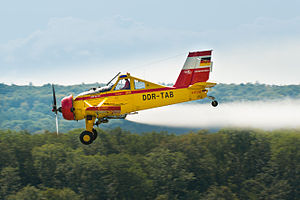PZL-106 Kruk
| PZL-106 Kruk | |
|---|---|
 |
|
| PZL-106A at the oldtimer aircraft meeting, 2013, | |
| Role | Agricultural aircraft |
| National origin | Poland |
| Manufacturer | WSK PZL Warszawa-Okęcie |
| First flight | April 17, 1973 |
| Status | in production |
| Primary users | Polish civilian aviation East Germany / Argentina |
| Produced | 1976- |
| Number built | 275+ |
The PZL-106 Kruk (English: Raven) is a Polish agricultural aircraft designed and built by WSK PZL Warszawa-Okęcie (later PZL "Warszawa-Okęcie" and now EADS-PZL).
The PZL-106 was developed as a modern agricultural aircraft for Poland and Comecon countries, to replace the less capable PZL-101 Gawron and aging PZL Antonov An-2. (According to Comecon decisions, Polish industry was responsible for developing agricultural aircraft). There were several agricultural plane designs proposed in the early 1960s by a group of young designers from WSK PZL Warszawa-Okęcie, led by Andrzej Frydrychewicz. These proposals were made on their own initiative, but never realized because the USSR was content with the An-2 and was planning to replace it with a jet aircraft (later PZL M-15 Belphegor). The first was the PZL-101M Kruk 63 of 1963. That remained a paper aeroplane, but did give its name to later designs. Next were the PZL-106 Kruk 65 (1965), PZL-110 Kruk-2T (1969) and PZL M-14 Kruk (1970, it was planned to produce this variant in PZL-Mielec). Only in 1971 did the authorities decide to start development of the new agricultural design as the PZL-106 Kruk 71. Despite this decision, its development was quite protracted, due to both economic and political reasons. The work, led by Andrzej Frydrychewicz, started in 1972, and was based on earlier designs. The first prototype was flown on April 17, 1973. The designers chose a safe layout of a braced low-wing monoplane with a container for chemicals in front of the pilot, and was inspired by planes like Piper PA-25 Pawnee (in case of an emergency landing, the container would not crush the higher sitting pilot).
The first prototype was powered by an imported 298 kW (400 hp) Lycoming IO-720 flat-eight-cylinder engine and had a T-tail with wings of wooden construction. There were several prototypes built, and the plane was finally fitted with a 441 kW (600 hp) PZL-3S radial engine, a conventional tail and metal wings. The prototype with the final engine first flew on 25 October 1974.
...
Wikipedia
